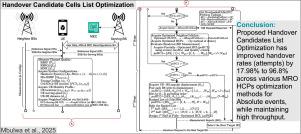Mitigation of frequent-handover in 5G and beyond using handover candidate cells list optimization
IF 4.8
3区 计算机科学
Q1 COMPUTER SCIENCE, INFORMATION SYSTEMS
引用次数: 0
Abstract
5G and beyond networks require diverse spectrum allocations: lower band for coverage, mid-band for both coverage and capacity, and higher band for high to ultra-high data rates. To meet increasing capacity demands, small cells are deployed, significantly increasing base station (BS) proximity and network densification. This results in frequent handovers; In existing techniques, the handover candidate cells list (HCL) are reported as-is to the target selection (handover decision-making) stage, which results in “unnecessary” cells included as potential handover target, leading to high unnecessary handovers, ping-pong effects, and handover failures, causing signaling overhead, network congestion, and session disruptions for mobile users. This paper proposes an optimization approach for HCL to improve handover performance in 5G and beyond networks. The approach utilizes mobility load balancing (MLB) to identify overloaded cells/BSs in the neighbor cells list (NCL), which are then excluded from the HCL prior to the target selection stage. Additionally, it considers angular displacement (proximity) to remove cells that are significantly displaced from the UE’s direction of movement. This process reduces or eliminates potentially unnecessary candidates from the handover decision phase, thereby minimizing frequent handovers, unnecessary handovers, ping-pong effects, and handover failures. A comparative analysis is presented for the handover procedure with and without HCL optimization, in both manual and auto-tuning mobility robustness optimization (MRO) methods, in absolute and relative handover measurement strategies (events). The results indicate that HCL optimization significantly enhances handover performance across various MRO methods for absolute handover measurement events while maintaining high throughput. Handover performance improvements range from 17.98% to 96.80% for the handover rate (HR)/frequency, 58.56% to 99.75% for the ping-pong handover rate (PHR), 0.62% to 84.29% for the unnecessary handover rate (UHR), and 66% to 99.90% for the handover failure rate (HFR). This analysis suggests that HCL optimization should be considered a vital component in the design and implementation of handover management and control to maximize efficiency and reliability. The proposed approach optimizes handovers with minimal additional complexity, making it a viable solution for 5G and beyond networks.

基于切换候选小区列表优化的5G及以上频率切换缓解
5G及以后的网络需要多样化的频谱分配:低频段覆盖,中频段覆盖和容量,高频段用于高到超高数据速率。为了满足不断增长的容量需求,部署了小型蜂窝,显著增加了基站(BS)的接近度和网络密度。这导致了频繁的交接;在现有技术中,切换候选单元列表(HCL)是按现状报告到目标选择(切换决策)阶段的,这导致“不必要的”单元被包括为潜在的切换目标,导致大量不必要的切换、乒乓效应和切换失败,导致移动用户的信令开销、网络拥塞和会话中断。本文提出了一种优化HCL的方法,以提高5G及以上网络的切换性能。该方法利用移动性负载平衡(MLB)来识别邻居单元列表(NCL)中的过载单元/BSs,然后在目标选择阶段之前将其从HCL中排除。此外,它还考虑了角位移(接近度),以去除明显偏离UE运动方向的细胞。这个过程减少或消除了移交决策阶段潜在的不必要的候选,从而最大限度地减少了频繁的移交、不必要的移交、乒乓效应和移交失败。对比分析了采用HCL优化和不采用HCL优化的切换过程、手动和自动调整迁移鲁棒性优化(MRO)方法、绝对和相对切换测量策略(事件)。结果表明,在保持高吞吐量的同时,HCL优化显著提高了各种MRO方法的绝对切换测量事件的切换性能。切换率/频率提升17.98% ~ 96.80%,乒乓切换率(PHR)提升58.56% ~ 99.75%,不必要切换率(UHR)提升0.62% ~ 84.29%,切换失败率(HFR)提升66% ~ 99.90%。这一分析表明,在设计和实现交接管理和控制时,HCL优化应被视为一个重要组成部分,以最大限度地提高效率和可靠性。所提出的方法以最小的额外复杂性优化了移交,使其成为5G及以上网络的可行解决方案。
本文章由计算机程序翻译,如有差异,请以英文原文为准。
求助全文
约1分钟内获得全文
求助全文
来源期刊

Ad Hoc Networks
工程技术-电信学
CiteScore
10.20
自引率
4.20%
发文量
131
审稿时长
4.8 months
期刊介绍:
The Ad Hoc Networks is an international and archival journal providing a publication vehicle for complete coverage of all topics of interest to those involved in ad hoc and sensor networking areas. The Ad Hoc Networks considers original, high quality and unpublished contributions addressing all aspects of ad hoc and sensor networks. Specific areas of interest include, but are not limited to:
Mobile and Wireless Ad Hoc Networks
Sensor Networks
Wireless Local and Personal Area Networks
Home Networks
Ad Hoc Networks of Autonomous Intelligent Systems
Novel Architectures for Ad Hoc and Sensor Networks
Self-organizing Network Architectures and Protocols
Transport Layer Protocols
Routing protocols (unicast, multicast, geocast, etc.)
Media Access Control Techniques
Error Control Schemes
Power-Aware, Low-Power and Energy-Efficient Designs
Synchronization and Scheduling Issues
Mobility Management
Mobility-Tolerant Communication Protocols
Location Tracking and Location-based Services
Resource and Information Management
Security and Fault-Tolerance Issues
Hardware and Software Platforms, Systems, and Testbeds
Experimental and Prototype Results
Quality-of-Service Issues
Cross-Layer Interactions
Scalability Issues
Performance Analysis and Simulation of Protocols.
 求助内容:
求助内容: 应助结果提醒方式:
应助结果提醒方式:


